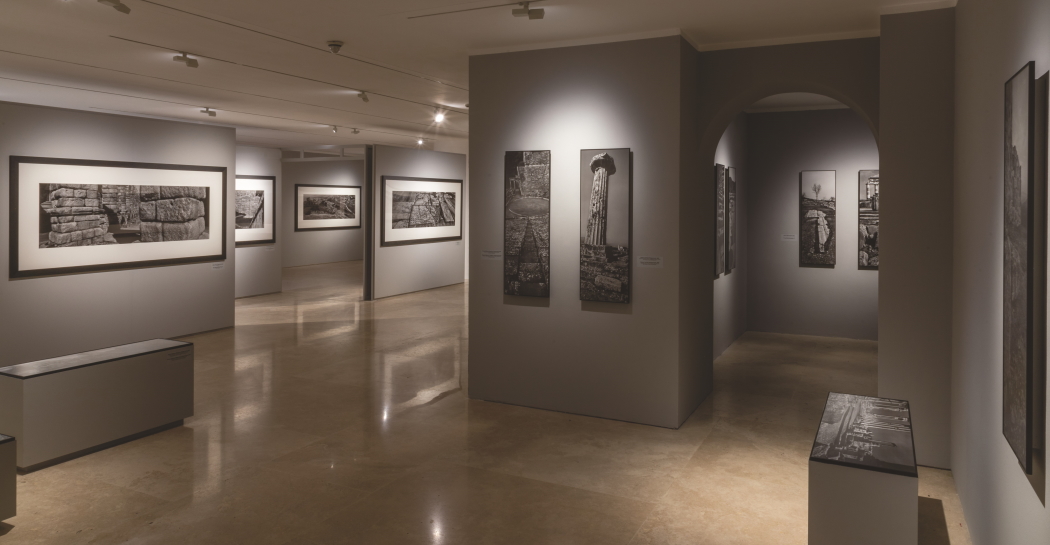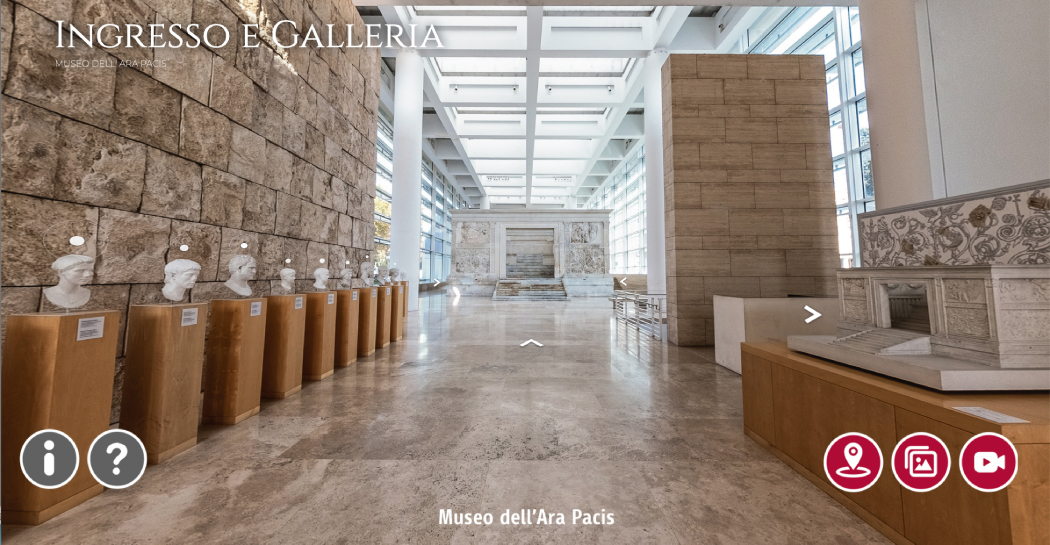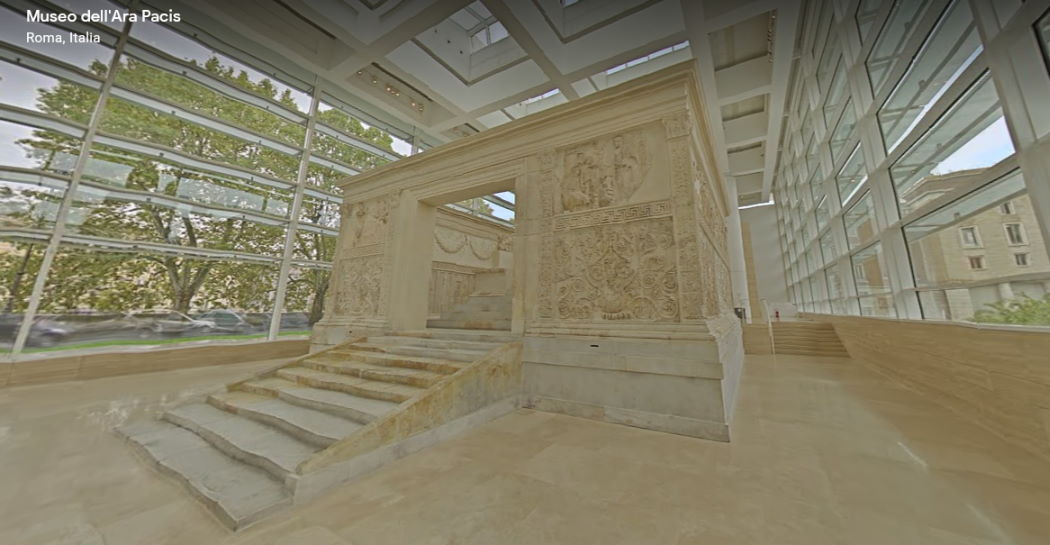Exhibitions and events online
The section Exhibitions and events online, created during the closing period of the museums, guides the visitor on an exploration journey through the video stories of the curators.

EXHIBITION Helmut Newton. Legacy
In the occasion of this exhibition, through the Media Partnership between the Sovrintendenza Capitolina and the Direzione Rai Pubblica Utilità (RAI EASY WEB and Facebook Rai Accessibilità) , audio and video content complete with subtitles and LIS translation was produced.
The accessible videos are by RAI PUBLICA UTILITA'
Description of photos: MARCO SAVEGNAGO
LIS translation: ARGENTINA CIRILLO - for the photo part; MARIA CRISTINA CUCCURULLO - for the information part and introduction to the individual Sections -
Narrator: MORGANA GIOVANNETTI - for the photo part; GAETANO LIZZIO - for the information part and introduction to the individual Sections
Introduction
Beginnings
The Sixties
The Seventies
The Eighties
The Nineties
Last Years
Portrait Helmut Newton
June as Hedda Gabler
At the French-Belgian Border, French Vogue
John Bates, British Vogue
Mansfield, British Vogue
Rue Aubriot, Yves Saint Laurent, French Vogue e Rue Aubriot, Yves Saint Laurent
Catherine Deneuve, Esquire
11:30 a.m., Italian Vogue e 12:30 p.m., Italian Vogue
Big Nude I: Lisa, Big Nude II, Big Nude III: Henrietta, Big Nude IV, Big Nude V: Henrietta
Self-portrait with wife and models, Vogue Studio
Italian Vogue
Carrè Otis, Blumarine
EXHIBITION Lucio Dalla. Anche se il tempo passa
A visual and sensorial journey, an immersive experience, transforming the exhibition space into a scenic box
Mauro Iandolo interprets Lucio Dalla's 'La sera dei miracoli' in Italian sign language (LIS)
Mauro Iandolo interprets Lucio Dalla's 'Cara' in Italian sign language (LIS)
Mauro Iandolo interprets Lucio Dalla's '4 marzo 1943' in Italian sign language (LIS)
EXHIBITION Robert Doisneau
Introductory video by the curator
Every exhibition is a story. Even more so is this one by Robert Doisneau, in which each photograph encapsulates a universe of moments, sensations, glances, stories, anecdotes.
We have chosen some of them for you. We tell you about them in our Video Podcast series "10 photos for 10 stories".
Robert Doisneau, L'enfer (1952)
A representative of order framed by a 'hellmouth', the entrance to a licentious Parisian cabaret.We start from this somewhat paradoxical image, our tale in 10 images and as many stories, anecdotes, curiosities with which we will make you better acquainted with this refined photographer who liked to call himself, a fisherman.
Robert Doisneau, Le Fox Terrier du Pont des Arts (1953)
Robert Doisneau was great not only at capturing the moment, as great photographers do, but also at inventing it, as great artists do, while giving us the illusion, as great conjurers do, that the photo is the result of chance...
Robert Doisneau, Promenade dominicale (1934)
This image hides a clue to an unsuspected character trait for a 'street photographer': shyness. Would you ever have guessed it? Robert Doisneau initially dared not photograph people (the rolleiflex helped him in this) and yet he had the feeling that he could see them very well...
Robert Doisneau, Les FFI de Ménilmontant (1944)
There is always a shot to which a photographer is particularly attached. For Doisneau it was this one, taken during the summer of '44 while wandering around a Paris that had just been liberated from the Nazis, in days when even a banal stroll could turn out to be anything but.
Robert Doisneau, Mademoiselle Anita (1951)
If all of #Doisneau's work is at bottom a self-portrait, well this photograph - beautiful and melancholic - is doubly so: in the right-hand corner you can see the photographer reflected in the mirror, and you can see him twice because the mirror forms a corner.
Robert Doisneau, Prise de vues publicitaire (1935)
This is a perfect, a little bit ironic and surreal advertising shot. The journey through Doisneau's photography continues with this image from his time at Renault. Take two minutes for yourself, get comfortable and let's get going.
Robert Doisneau, Comtesse Gaëlle et Monsieur Pedro (1950)
Many exhibitions have been dedicated to Doisneau, but this one is different, because the curator, Gabriel Bauret, has scoured the 450,000 negatives in the archive to distil a selection capable of sketching a "full-length" portrait of the artist: so alongside the essential shots there are also little-known photos, such as the one we tell you about today in this new video.
Robert Doisneau, Cafè noir et blanc (1948)
A married couple at a bistro counter. And that is already a story. If we then add a fine director like Doisneau, the image will speak to us on many levels.We invite you to enter this 'Café in black and white' with us.
Robert Doisneau, Blaise Cendrars à Saint Segond (1948)
This photo is the incipit of the friendship between Doisneau and the poet and storyteller, Blaise Cendras. Deeply impressed by the irreverent, anti-academic, immediate, profound shots of a young, little-known photographer, Cendras proposed to him that they produce together the famous book "The banlieu of Paris", which Doisneau himself would call "my most intimate self-portrait".
Robert Doisneau, Baiser de l'hotel de ville (1950)
How is an icon born? Here is the story behind one of the most famous kisses in the history of photography.
Video by I Cammelli
EXHIBITION Josef Koudelka. Radici
The exhibition documents with over one hundred extraordinary images Josef Koudelka's photographic journey in search of the roots of our history in the most important archaeological sites of the Mediterranean.
Josef Koudelka. Radici | Alessandra Mauro
Twenty-eight years of observation, of travel, of looks. In these 28 years, Josef Koudelka, a Czech photographer naturalised as a Frenchman, has visited the most important archaeological sites in the Mediterranean and described them through spectacular images. In this video, Alessandra Mauro, editorial director of Contrasto, talks about the exhibition Radici by Josef Koudelka.
Radici. Josef Koudelka | Roberto Koch
Josef Koudelka has visited more than two hundred archaeological sites around the Mediterranean in twenty different countries, returning several times to get the most out of his photographic work. In this video, Roberto Koch, editor of the book Radici (Contrasto), talks about Josef Koudelka's exhibition.
Radici. Josef Koudelka | Lucia Spagnuolo
The Ara Pacis Museum is the ideal place to host Josef Koudelka's ambitious and original project: the photographer's gaze on the ancient world dialogues perfectly with the archaeological finds on the museum's upper floor. In this video Lucia Spagnuolo, curator of archaeology at the Ara Pacis Museum, talks about the exhibition Radici by Josef Koudelka.
EVENT Radici. Sguardi sulla mostra
Four free online meetings for the exhibition Josef Koudelka. Radici. Evidenza della storia, enigma della bellezza. Appointments in streaming with the photographer Andrea Jemolo, the archaeologist Emanuele Greco, the geographer Franco Farinelli, the archaeologist Simone Foresta.







































